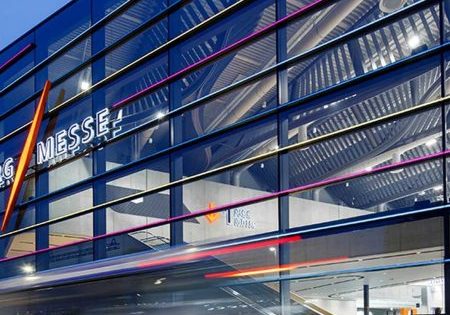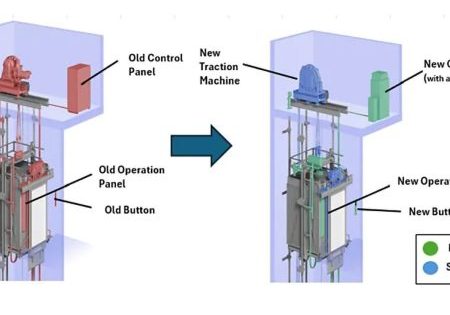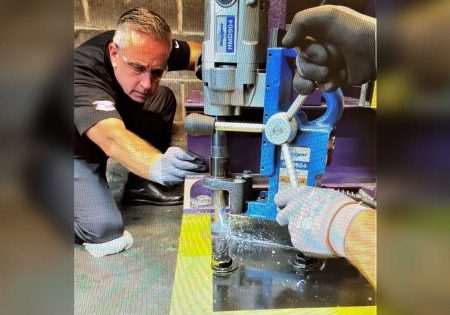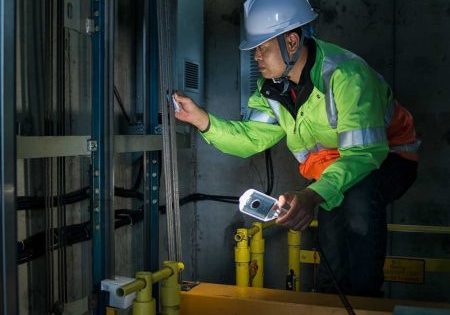The Technological Diet & the Four Revolutions of the Elevator Industry
May 1, 2025
by Fernando Lueje and Alea Guillemi
This paper was presented at the 2024 International Elevator & Escalator Symposium in Paradise Island, Bahamas.
Wittur Group is constantly working to revolutionize the elevator market in Latin America by offering a complete and innovative solution with cutting-edge technology. Its mission is to provide comprehensive solutions (components and complete systems) that are safer, sustainable, economical and ecological, while being easy to manufacture, install and maintain, especially in a region with low resources and limited economic capabilities that not only improve the end customer’s experience, but also have a positive impact on the environment and the economy.
The ECOBELT URBAN (H) and FLEX (C) were developed based on that concept. They prioritize automation in manufacturing and the implementation of production systems like the Toyota production system based on Lean manufacturing and the just-in-time concept, with implementation of continuous improvement under QRQC (Quick Response Quality Control) and KAIZEN methodology to guarantee maximum efficiency and consistent quality in each unit produced.
1. Introduction
Market consolidation and globalization have had a profound impact on the elevator industry worldwide. In particular, these forces have transformed approaches to the maintenance and security of these critical urban mobility systems. Multinational companies (MNCs) have played a central role in this transformation, imposing new standards through the integration of advanced technologies, such as components and methods that favor predictive maintenance, with the aim of reducing costs, optimizing operation and improving safety. This work analyzes how these changes have been seen as a great advantage and are beginning to significantly influence emerging markets such as Latin America, with a special focus on Argentina and Brazil.
In a context where independent companies have historically dominated the Latin American market (especially in Argentina), the arrival of large MNCs with their factories in the Brazilian market to supply the region has generated both challenges and opportunities. The introduction of technologies such as the one used in ECOBELT line systems and other digital solutions has improved efficiency in elevator maintenance and raised safety standards, but it has also created a technological gap that local actors must address. This paper aims to explore this phenomenon, analyzing the main impacts of consolidation and globalization on the maintenance and safety of elevators in the region.
2. The Evolution of Machines and the Technological Diet
Over the past few decades, the elevator industry has seen significant evolution in machine design and functionality, driven by technological advances and the need to improve both operational efficiency and safety. Historically, elevator systems relied on gear-based drive (GEAR) machines, which required constant maintenance, including lubrication and regular adjustments. However, over time, the introduction of gearless drive machines, also known as permanent magnet (GEARLESS) machines, revolutionized the industry.
This type of machine offers multiple advantages: they are more compact, require less maintenance, do not need lubrication and, most importantly, allow for more energy-efficient operation and high travel performance. These innovations have allowed modern elevators to be more reliable and environmentally friendly, significantly reducing operating costs and environmental impact.
One of the most relevant transformations was the ability to develop elevators without a machine room, technology that has been promoted by MNCs in the region and is only now arriving in some countries in the region, such as Argentina. In this typology, the machines can be installed within the elevator shaft itself. This is especially useful in our area of influence, and has been a key factor in reducing the trend toward hydraulic systems, which are very common in these local constructions. The elimination of the engine room not only saves space, but also facilitates cleaner and more efficient maintenance, integrating technologies that enable predictive maintenance.
This advance is part of what we call the technological diet (due to its drastic reduction in measurements and weight), a concept that encompasses the transition toward cleaner, more efficient technologies that are less dependent on traditional resources such as oil or the intensive use of metallic materials.
The technology diet concept also encompasses digitalization and remote monitoring, which have transformed the way elevators are managed. The incorporation of smart sensors and real-time monitoring systems, such as ElevatorSense, has enabled a transition toward predictive maintenance of automatic doors, where potential failures can be detected before they become critical problems. This combination of technologies is essential to achieving a more sustainable and efficient operation on a global level.
An example of how this concept has transformed the industry is the significant reduction in the weight of traction machines: While in the last century these machines weighed approximately 600 kg, today, thanks to these advances, they can weigh only 82 kg, allowing them to be transported in a regular car or easily lifted by two people. This change not only improves installation and maintenance logistics, but also reduces costs and facilitates adoption in buildings of various scales.
Furthermore, in regions such as Latin America, the technological diet is being progressively adopted. Multinationals are leading the way toward this transition, but local companies are also beginning to incorporate these innovations to compete in an increasingly globalized market. However, the full adoption of this transformation faces economic and regulatory challenges, as discussed in previous sections.
3. Impact of Consolidation and Globalization on Maintenance
In recent years, market consolidation has led to the integration of large global players in traditionally fragmented markets such as Latin America. This trend has allowed for greater standardization of maintenance practices, with a focus toward reducing costs and maximizing equipment uptime. Globalization, for its part, has facilitated the transfer of advanced predictive-maintenance technologies, allowing local operators to adopt solutions that were previously reserved for more developed markets.
A clear example of this trend is the introduction of technologies such as the ECOBELT system, developed by the Wittur Group in conjunction with an Argentine small to medium-sized enterprise, focusing the product on the majority typology used in this region. This system, based on the use of traction belts instead of traditional ropes, in conjunction with the design of the mechanics inspired by the hydraulic elevator (dominant in the territory), allows for simple installation, more efficient maintenance and reduction in the need for corrective interventions.
In markets such as Argentina and Brazil, where elevator infrastructure is varied and often obsolete, these innovations offer a viable solution to improving operational efficiency. However, the implementation of these technologies is not without challenges. Economic barriers, limitations on foreign trade and differences in regulatory frameworks between countries in the region and more developed economies have limited the mass adoption of these solutions.
4. Technological Innovations in Elevator Maintenance
The adoption of advanced technologies has been key to improving efficiency and safety in elevator maintenance globally. Among the main innovations, predictive-maintenance systems that stand out use sensors, maintenance-free components and digitalization, which allow continuous monitoring of the state of the equipment, identifying potential failures before they become critical problems. This approach significantly reduces downtime and costs associated with corrective maintenance, and is particularly relevant in markets such as Latin America where economic and infrastructure limitations complicate frequent interventions.
One of the most revolutionary technologies in this area is the full system ECOBELT, developed by the Wittur Group, which not only uses belts instead of ropes for the suspension and traction of the elevator, but also other key components that indulge in the full concept of globalization and autonomy. The belts, covered with a special thermoplastic (TPU), have several advantages over traditional steel ropes, including a longer useful life, exempting them from the lubrication process and providing the ability to be monitored remotely to evaluate their wear and resistance. This approach not only improves safety, but also reduces environmental impact by reducing the need for lubricants and technician travel.
In addition to ECOBELT, Wittur has introduced components specifically designed for preventive and predictive maintenance, such as permanent-magnet machines that do not require lubrication and guide rollers that inhibit the use of grease in the guide rails, which reduce friction and heat generated in the system, achieving a total efficiency of 90%. Another important advance is the use of the ESG or electronic safety gear, an advanced safety system that not only guarantees the protection of passengers, but also that of maintenance technicians. This system, combined with speed and positioning sensors, offers a complete solution that facilitates remote monitoring and reduces manual interventions.
ElevatorSense is another of the innovative technological solutions developed by Wittur. It is a system based on the Internet of Things (IoT) that allows real-time monitoring of elevator doors through the integration of smart sensors. These sensors collect data on equipment operation, allowing problems to be identified before serious failures occur. ElevatorSense not only optimizes elevator operation, but also reduces callbacks and downtime, improving service quality and reducing costs associated with maintenance. This solution is especially useful for maintenance technicians, allowing them to perform precise diagnoses and plan preventive interventions more efficiently (Wittur ElevatorSense).
Ecobelt System
Traction Belts
Machine-room-less (MRL) elevators are a growing trend in the lifting industry due to their efficiency, compact design and reduced space requirements. One of the key components in these systems is the traction belt, which offers several benefits over traditional ropes. Below are the seven main benefits of using traction belts in elevators without a machine room:
- Lower weight and greater flexibility: Tensile belts are significantly lighter than conventional steel ropes. This not only reduces the total load that the motor must move, but also improves the energy efficiency of the system. The flexibility of the belts allows smaller diameter pulleys to be designed, which is ideal for MRL elevators where space is limited.
- Durability and less wear: Traction belts are made of high-resistance materials, such as polyurethane reinforced with steel or fiber ropes. This gives them greater durability and resistance to wear compared to traditional ropes. Less wear means less need for maintenance, reducing operating costs over the life of the elevator. Useful life: 10 million cycles.
- Quieter operation: Thanks to their softer and more flexible design, traction belts generate less vibration and noise during operation. This results in a more comfortable and quiet ride, which is especially important in residential or commercial buildings where comfort is key.
- Greater security: Modern traction treadmills often have built-in monitoring systems that detect the condition of the treadmill’s internal threads. For example, through a direct-current device that measures and detects if any of the cable wires have been cut, security of the system is increased. Breaking resistance of 43 kn versus 38 kn of steel ropes is provided.
- Reduction in motor size: Due to their lower weight and ability to operate with smaller diameter pulleys, traction belts allow the use of smaller, more efficient motors. This not only saves space, but also reduces energy consumption, aligning with sustainability and energy-efficiency trends.
- Space optimization: By not requiring a machine room and thanks to their compact design, MRL elevators with traction belts make better use of the available space in a building. This is especially beneficial in renovation projects or in buildings where space is limited.
- TPU Coverage:
- Elasticity and flexibility: TPU is highly elastic, allowing it to deform under stress and return to its original shape without damage. This is ideal for applications requiring durability and fatigue resistance, such as traction belts that are repeatedly bent and stretched.
- Abrasion resistance: It is very resistant to wear and abrasion, making it suitable for components that are in continuous contact or subject to friction, such as elevator ropes or belts.
- Chemical resistance: TPU is resistant to oils, greases and various chemicals, which improves the durability of products made from this material.
- Resistance to low and high temperatures: It can maintain its flexibility and properties over a wide range of temperatures, making it useful in extreme environments.
- Sustainability: Unlike other plastics, TPU is recyclable. It can be melted and reshaped without losing its properties, making it a more sustainable option.
- Uses of TPU in the elevator industry: In elevator technology, such as the ECOBELT system mentioned above, TPU-coated traction belts provide longer life compared to traditional steel ropes, as well as require less maintenance as they do not need to be lubricated. Additionally, its ability to monitor remotely allows for better supervision and failure prevention.
Sensors for Suspension and Cabin Array
Sensors and load-measurement solutions for elevators stand out for their focus on advanced technology and innovation in the sector. Located in a modern facility and equipped with the latest technology, Wittur has established itself as a leader in the design and manufacture of precise and reliable devices that guarantee the safety and optimal performance of lifting systems. Solutions include:
- Weight sensors: These devices measure with high precision the weight and tensions in elevators, ensuring that the system operates within established safety parameters.
- Monitoring systems: The company offers continuous monitoring solutions that allow real-time monitoring of loads and weight distribution in the elevator, preventing overload situations and improving safety.
- Tension control systems: These systems detect any imbalance in the tensions of the ropes or belts, contributing safer and more efficient operation of the elevator.
- Predictive-maintenance devices: By analyzing usage and wear patterns, these products allow you to anticipate possible failures, optimizing maintenance and reducing downtime. They provide:
- Precision: They offer highly accurate measurements, which is crucial to ensure the safety and proper operation of elevators.
- Reliability: They provide consistent results over time.
- Easy installation: The design allows for quick and easy installation, minimizing downtime in elevator installation.
- Advanced technology: Continuous, real-time monitoring of loads and constant measurement of tensions in the elevator.
- Compatibility: High compatibility with elevator systems, which makes them versatile and adaptable to different configurations.
- Reduction of maintenance costs: By detecting and preventing problems before they become serious failures, these products help reduce maintenance costs.
- Regulatory compliance: They comply with international safety regulations, ensuring that elevators operate under the highest standards.
- Improved security: By constantly monitoring loads and weight distribution, they help avoid overload situations or dangerous imbalances.
Roller Guides
The roller guides of both the car (cabin) and the counterweight in elevators play a fundamental role in ensuring smooth and safe movement. Benefits of roller guides in the car (cabin) include:
- Vibration reduction: Roller guides help minimize vibrations during cabin movement, providing a smoother and more comfortable ride for passengers.
- Silent operation: Guide rollers eliminate or significantly reduce noise generated during elevator movement, creating a quieter environment, ideal for residential and commercial settings.
- Greater stability: Roller guides keep the car centered and aligned within the elevator shaft, avoiding sudden lateral movements that could affect the comfort or safety of passengers.
- Less wear on guides: By better distributing the load and offering more uniform contact, rollers reduce wear on the guides, prolonging their useful life and minimizing the need for maintenance.
- Greater energy efficiency: By reducing friction between the cab and the guides, roller guides allow the lifting system to operate more efficiently, which can translate into lower energy consumption.
Benefits of roller guides on the counterweight
- More controlled movement: As in the car, the counterweight roller guides ensure controlled and smooth movement, avoiding unwanted oscillations or vibrations during its journey.
- System life extension: By reducing wear on both the rollers and counterweight guides, you extend the life of these key elevator components, reducing the frequency of repair or replacement.
- Load optimization: Roller guides in the counterweight ensure correct weight distribution, which contributes to the balance and stability of the entire elevator system.
- Less friction: By reducing the friction between the counterweight and the guides, the elevator system experiences less mechanical stress, which improves motor efficiency and reduces energy consumption.
Roller guides in both the elevator car and counterweight provide key advantages in terms of comfort, safety, energy efficiency and reduced maintenance, making the system run more smoothly and with less wear and tear in the long term.
Electronic Safety Gear
Wittur’s ESG electronic safety gear is an advanced elevator safety system that offers several important benefits.
Benefits of the Wittur ESG electronic safety gear:
- Greater precision in activation: Unlike traditional mechanical systems, the ESG electronic safety gear activates precisely, improving response to emergency conditions such as cabin overspeed.
- Smooth and controlled activation: Thanks to electronic technology, the system allows for smoother deceleration of the cabin, reducing the impact and increasing the safety and comfort of passengers in the event of an emergency.
- Less mechanical wear: By not relying exclusively on mechanical components for activation, the ESG system reduces wear and tear and the need for frequent maintenance, which translates into lower long-term operating costs.
- Continuous monitoring: The ESG safety gear is integrated with real-time monitoring systems that continuously monitor the status of the elevator, facilitating early detection of possible failures or problems in the system.
- Compatibility with safety regulations: This system complies with the strictest international regulations in terms of elevator safety, ensuring that the equipment is always in compliance with regulations.
- Reduction of space and weight: Being an electronic system, it requires less space than traditional mechanical devices, which is an advantage in modern elevators, especially those without a machine room (MRLs). In addition, being lighter, it contributes to improving the efficiency of the elevator.
- Removal of additional components: Overspeed governor, buffers, limits and positioning magnets will no longer be necessary with the incorporation of this component.
- Ease of integration: Wittur’s ESG electronic safety gear can be easily integrated into new systems or retrofits, making it a flexible and adaptable solution for different elevator configurations.
- Greater reliability: Electronic technology offers greater reliability by reducing the risk of failures related to mechanical wear, ensuring consistent and safe operation over time.
Wittur’s ESG electronic safety gear offers a combination of precision, safety, efficiency and reduced maintenance, making it an advanced and reliable solution to improve the safety of modern elevators.
ElevatorSense
ElevatorSense is an advanced monitoring and management technology for elevators that optimizes performance, safety and user experience.
Main benefits of ElevatorSense:
- Real-time monitoring: ElevatorSense allows you to monitor elevator operation in real time, making it easy to early detect faults or problems before they become serious incidents. This improves safety and reduces downtime.
- Predictive maintenance: By continually analyzing elevator behavior, the system identifies wear patterns and anticipates the need for maintenance, reducing unexpected breakdowns and prolonging component life.
- Savings in operating costs: The ability to perform preventative and predictive maintenance decreases operating costs associated with emergency repairs and premature component replacement.
- Improvement in energy efficiency: ElevatorSense optimizes energy use by efficiently managing elevator operating and rest times. This translates into lower energy consumption and more sustainable operation.
- Greater security: Continuous monitoring technology also contributes to increasing passenger safety by alerting operators to any anomalies or potential problems that could compromise the operation of the elevator.
- Improved user experience: By keeping the elevators in optimal conditions, a more fluid and comfortable trip is ensured for users, reducing wait times and improving comfort during travel.
- Detailed reports and data analysis: ElevatorSense provides detailed information about elevator usage and performance, allowing operators and managers to make data-driven decisions to improve facility management.
- Compatibility with different systems: ElevatorSense easily integrates with a variety of lifting systems, making it a versatile solution adaptable to different types of projects.
- Reduced downtime: Thanks to the ability to proactively detect faults, the periods in which the elevator is not operational are minimized, guaranteeing greater equipment availability.
In summary:
ElevatorSense offers key benefits in terms of monitoring, predictive maintenance, energy efficiency and safety, optimizing elevator operation and improving the experience for both operators and end users.
In conclusion, a set of these elements in the ECOBELT System provides numerous key benefits for elevators:
- TPU-coated traction belt: Greater elasticity, flexibility and resistance to abrasion, chemicals and extreme temperatures, which extends life and reduces maintenance.
- Lower weight and greater flexibility: Allows smaller and more efficient motors, optimizes space and reduces energy consumption.
- Durability and less wear: Extends useful life and reduces operating costs.
- Silent operation: Increases comfort by reducing noise and vibration.
- Greater security: Continuous monitoring that detects failures in real time.
- Sensors: Accuracy in load monitoring, reliability and easy installation, contributing to safety and reducing maintenance costs.
- Roller guides: Reduction of vibrations, less friction and wear, improving stability and energy efficiency.
- Wittur ESG electronic safety gear: Precise activation and continuous monitoring, with less mechanical wear and more safety.
- ElevatorSense: Real-time monitoring and predictive maintenance, optimizing elevator performance, safety and operating costs.
Together, these elements improve the efficiency, safety and sustainability of modern elevators.
5. Regional Challenges: Latin America Facing Globalization and Consolidation; New Facilities in Latin America
Currently in Argentina, 3,000 elevators are sold per year. In Brazil, 12,500 per year are sold. While in Argentina the installation market is dominated by 90% independents (free market) and 10% by MNCs, in Brazil the ratio is almost the opposite, 20/80.
Despite the benefits that technological innovations and globalization bring, emerging markets such as those in Latin America face a series of specific challenges that limit the mass adoption of these solutions. Argentina and Brazil, which represent approximately 65% of new elevator installations in the region, are clear examples of how economic, regulatory and technological barriers have slowed down the modernization progress of the sector.
While in Europe predictive-maintenance technologies and digital-monitoring solutions have become standard, in Latin American countries these technologies are still in the implementation or initial testing phase. The lack of unified and updated regulations in the region makes the expansion of these solutions difficult, and many local companies are forced to continue using traditional maintenance methods, which are less efficient and more expensive in the long term.
One of the main challenges is lack of sufficient infrastructure and resources to implement advanced technologies consistently. While large multinationals have managed to integrate innovations such as ECOBELT and ElevatorSense into their processes, many local independent companies are limited by the high investment costs required to adopt these technologies. Lack of financing and scarcity of resources for R&D prevent these companies from updating as quickly as their international competitors.
An additional key factor in this region is the importance of space. Due to the technological gap that persists between Latin America and other more developed regions, MRLs have not achieved significant adoption. Instead, the hydraulic elevator has traditionally been the preferred option in low-rise buildings with few stops, since its installation requires less space and civil requirements. With new technologies, we are bringing top-level equipment, comparable to those of the multinationals, to small companies that do not have the capacity, technology or structure to develop MRL elevators by themselves. These innovations allow us to offer advanced and more efficient solutions, which gives local companies greater competitiveness in the market.
Another important challenge is resistance to change on the part of local actors. Although technological innovations promise higher performance and lower operating costs in the long term, many local companies are reluctant to modify their established work processes. This resistance is fueled by the perception that advanced technologies involve a high initial cost and a significant learning curve, discouraging companies from investing in new solutions.
Despite these obstacles, there are significant opportunities for companies that are willing to invest in new technologies and adapt to changing market conditions. Globalization has made innovative solutions available to a greater number of players, which can allow for a gradual modernization of the sector. Additionally, the growth of the construction sector in countries such as Brazil and Argentina is driving demand for more efficient and sustainable elevators, which could accelerate the adoption of advanced technologies in coming years.
Although Latin America faces significant challenges due to economic, regulatory and cultural barriers, globalization and market consolidation also offer opportunities for gradual modernization of the sector. Companies that adopt technological innovations such as ECOBELT and ElevatorSense will be better positioned to compete in this increasingly globalized and demanding environment.
The 2023 new elevator installation market in Argentina was segmented into 57% with gear machines (MR), 8% with gearless machines (MRL) and 35% with hydraulic drive systems (HI).
MR and HI electromechanical are mainly installed by independents. In buildings with up to five stops, the HI is used. In those with more stops, the electromechanical MR is used.
On the other hand, in Brazil, MNCs (Otis, TK Elevator, Schindler) install 95% of their equipment with their own MRL systems. The independent market is segmented, with 35% HI, 20% MRL and 45% gear MR (a total of approximately 2,500 lifts per year).
Conclusion
The globalization and consolidation of the elevator industry has brought about significant changes in the way the maintenance and safety of these systems is approached. In markets such as Latin America, where infrastructure still presents significant challenges, the introduction of advanced technologies such as the ECOBELT system, the ESG electronic safety gear, ElevatorSense and the constant monitoring of the condition and tension of the belts has opened new opportunities to improve the operational efficiency and raise safety standards.
The evolution of machines over time has been key to this transformation. The elevator industry has gone through three fundamental revolutions that have marked milestones in their development:
- First Revolution: The Safety Gear: The invention of the safety gear by Elisha Otis was the first major breakthrough, ensuring the safety of passengers and allowing the construction of taller buildings. This innovation was crucial for the vertical growth of modern cities.
- Second Revolution: The Counterweight: The incorporation of the counterweight improved the energy efficiency of elevators, optimizing their operation and reducing component wear, which contributed to extending the useful life of the equipment and reduced operating costs.
- Third Revolution: The Suspension Means: The invention of new suspension means has allowed the development of permanent magnet machines with direct drive without gear, which has allowed a notable evolution in travel performance, optimizing energy efficiency, protecting the environment and finally, providing great design versatility in civil constructions allowing the reduction of spaces with equipment without a machine room.
- Fourth Revolution: Introduction of Maintenance-Free Components and Digitalization: The invention of traction belts covered by reinforced TPU polyurethanes as a new drive system, replacing ropes as a traditional element to meet this objective, roller guides, electronic safety gears and components that allow products to be connected via the Internet, offer us greater durability and require less maintenance with the ability to perform it remotely and provide superior performance. This innovation is especially relevant in regions where infrastructure modernization is a priority, such as Latin America.
These advances are part of what is known as the technological diet, an approach that seeks the adoption of cleaner and more efficient technologies, such as permanent-magnet machines and continuous remote monitoring.
The technological diet is a global trend that not only improves the operation and safety of elevators, but also contributes to the sustainability of the sector. The reduction in the size and weight of equipment, together with the use of advanced technologies, has allowed modern elevators to be more efficient, less polluting and easier to maintain.
Although the adoption of these technologies is not without challenges — such as lack of financing, regulatory fragmentation and resistance to change — the long-term benefits are clear. Companies that adopt these technological advances will be better prepared to face the demands of an increasingly globalized market. Furthermore, the transition to this technological diet will not only transform operational efficiency and reduce environmental impact, but will also improve safety, providing a more robust framework for vertical transportation in the future.
In short, the four revolutions of the elevator, together with the adoption of advanced technologies — such as traction belts, permanent monitoring and digital security systems — allow us to glimpse a future where vertical mobility is increasingly safer, efficient and sustainable. Companies that manage to integrate these advances will be at the forefront of a rapidly evolving sector.
Get more of Elevator World. Sign up for our free e-newsletter.









